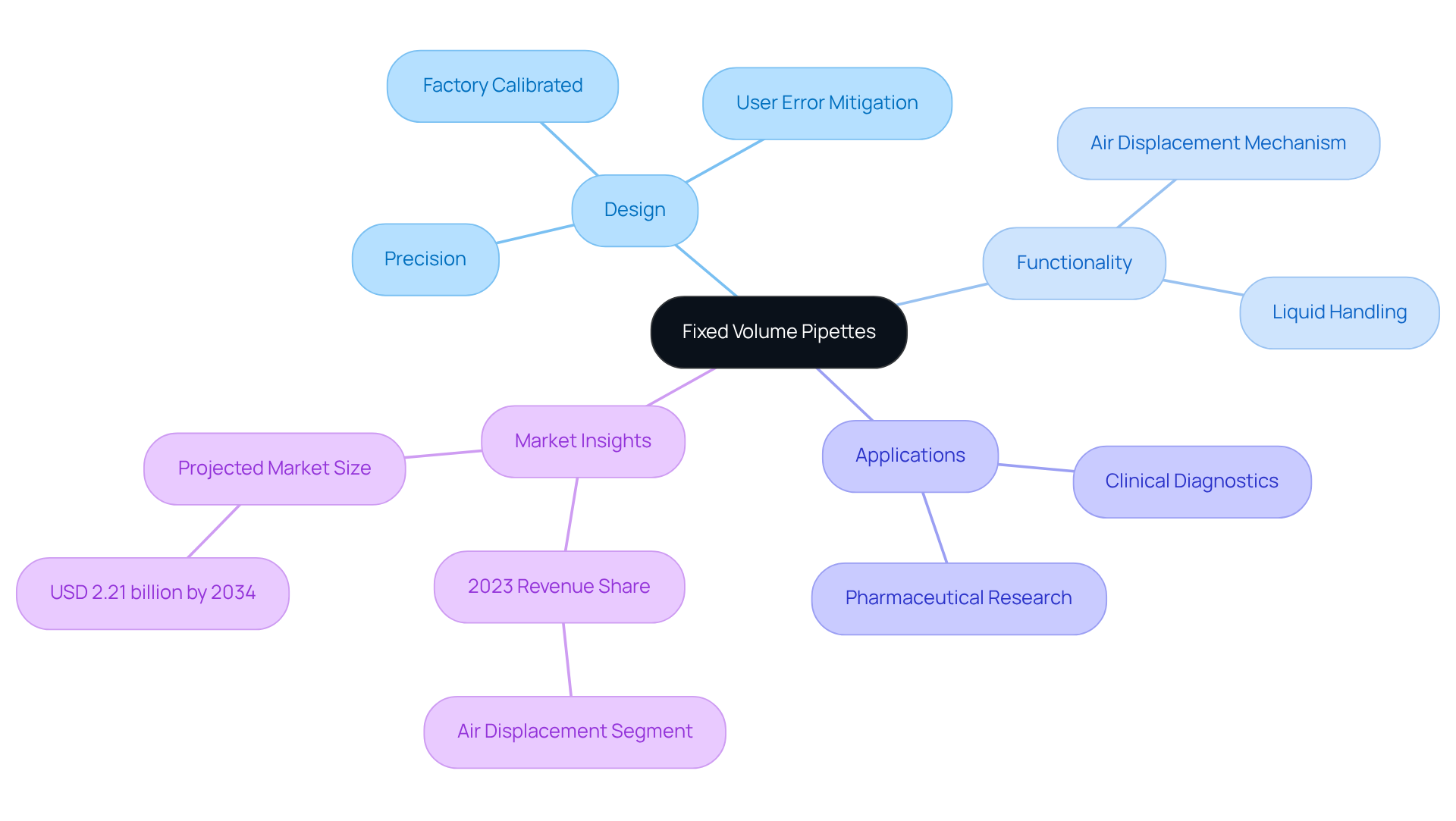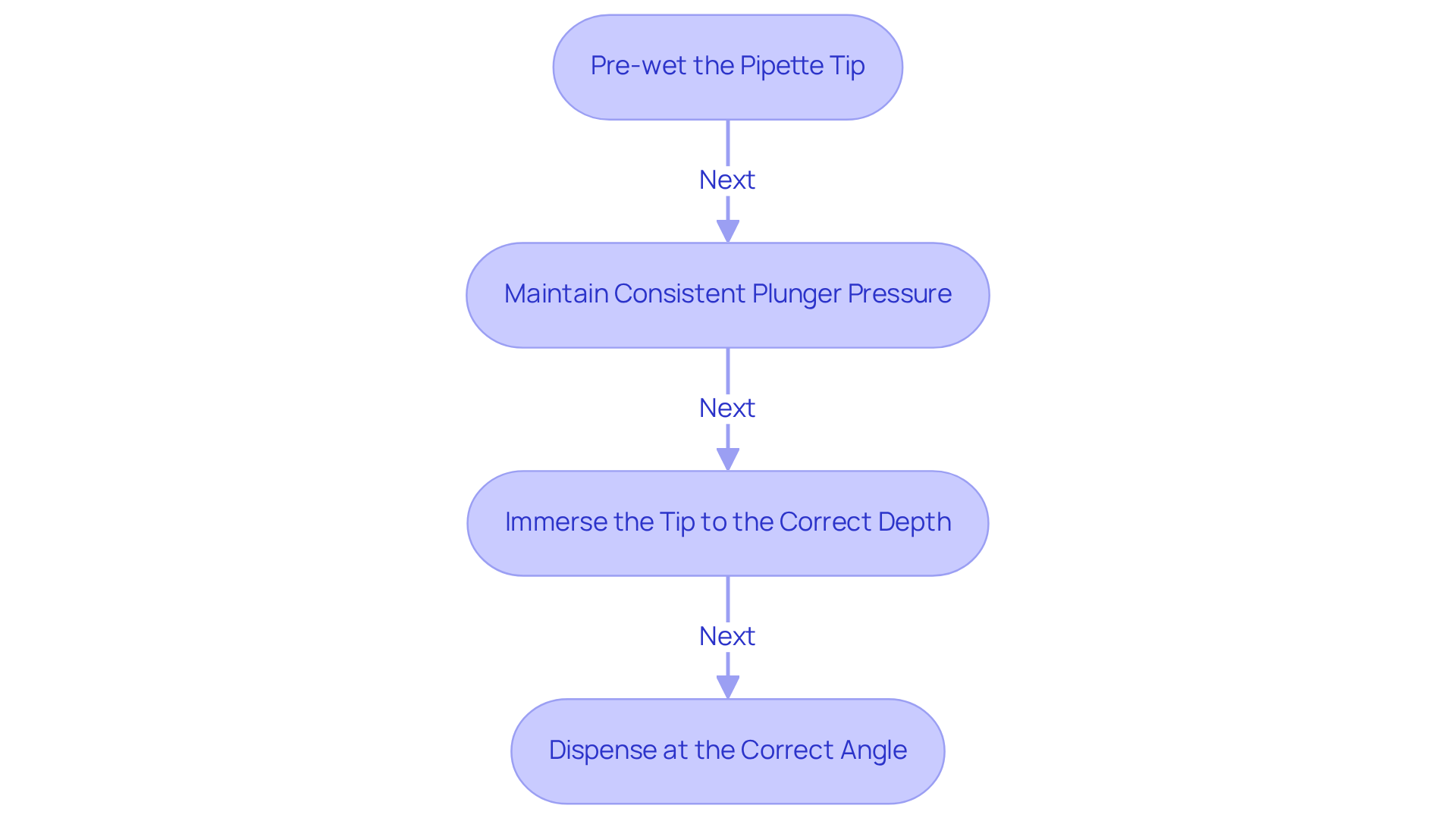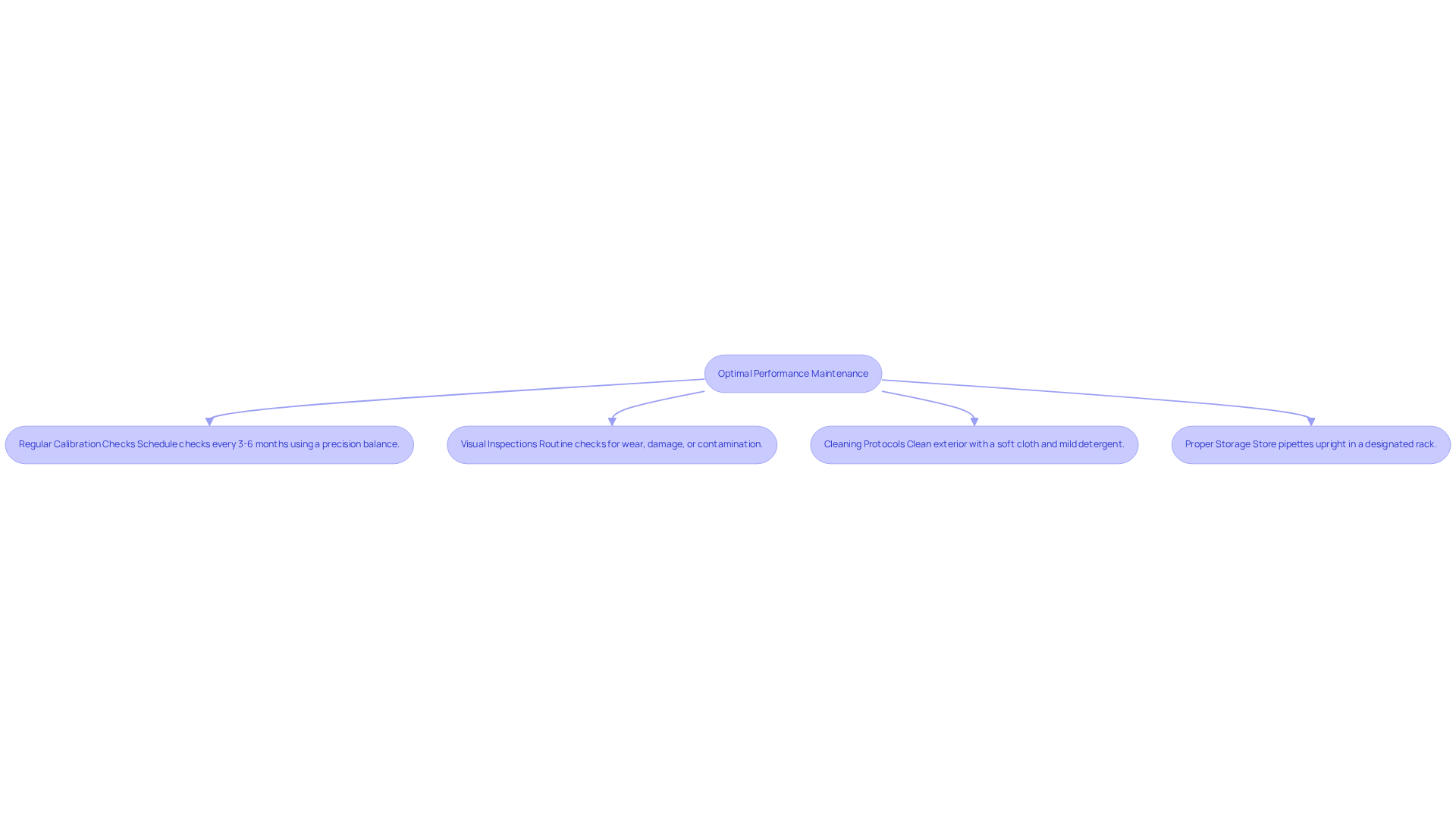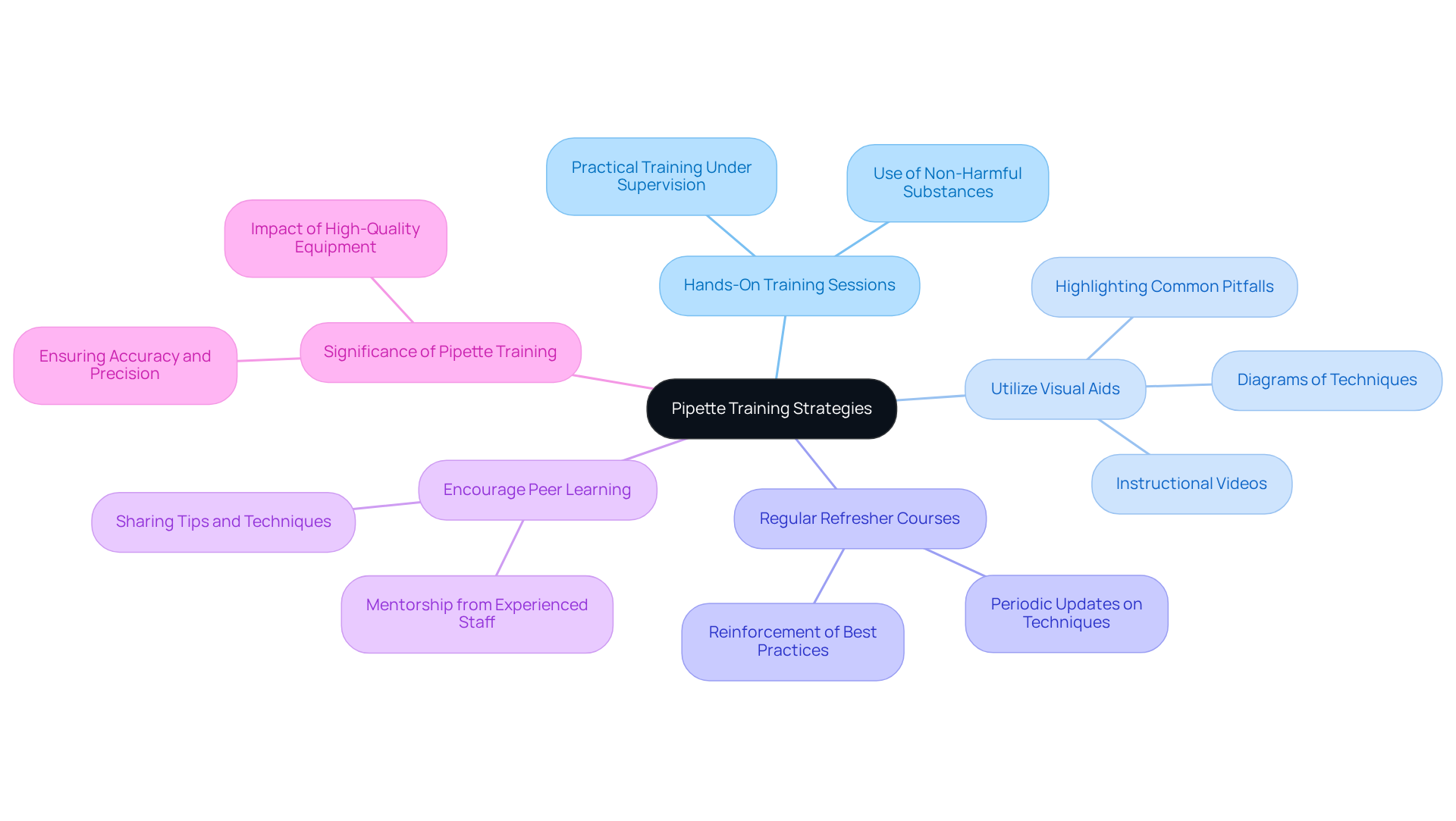Overview
This article presents best practices for the effective use of fixed volume pipettes, underscoring techniques that enhance accuracy and reliability in laboratory environments. It highlights essential practices such as:
- Pre-wetting the pipette tip
- Maintaining consistent plunger pressure
- Ensuring proper immersion depth
Each of these practices is supported by evidence demonstrating their critical role in achieving precise fluid measurements. By adhering to these guidelines, laboratory professionals can significantly improve their measurement outcomes, thereby reinforcing the importance of high-quality scientific instruments.
Introduction
Fixed volume pipettes are indispensable tools in laboratory settings, renowned for their precision and reliability in fluid dispensing. Their straightforward design significantly reduces user error, rendering them essential in high-stakes environments such as pharmaceutical research and clinical diagnostics. However, it is crucial to recognize that even the most advanced pipettes can produce inaccurate results if not utilized correctly.
What best practices can laboratory professionals adopt to ensure the highest level of accuracy and efficiency in their pipetting techniques?
Understand Fixed Volume Pipettes: Design and Functionality
Fixed volume pipettes are precision tools meticulously engineered to deliver a specific amount of fluid with exceptional consistency. In contrast to adjustable devices that allow for variable capacity settings, fixed volume pipettes are factory calibrated to dispense a singular, predetermined amount. This fundamental design significantly mitigates the risk of user error, thereby enhancing accuracy—an essential attribute for repetitive tasks in laboratory environments. Their straightforward operation and reliability render them particularly advantageous in high-throughput settings, such as pharmaceutical research and clinical diagnostics.
The mechanics of fixed volume pipettes operate based on the air displacement principle, where a piston mechanism draws in and releases fluids. This method proves particularly effective for transferring aqueous samples, ensuring precise liquid handling across diverse applications. For instance, the MP-SF fixed volume pipettes, which are designed for laboratory and research purposes, offer a capacity range from 5μL to 5000μL, making them ideal for tasks requiring consistent liquid dispensing.
The critical importance of fixed volume pipettes is underscored by their real-world applications in clinical diagnostics. In molecular biology and clinical settings, fixed volume pipettes are frequently employed, as precision and reliability are paramount. The simplicity of their design not only enhances operational efficiency but also guarantees high accuracy and repeatability in liquid dispensing, garnering positive feedback from laboratory professionals for their user-friendliness and dependability. As the pharmaceutical sector continues to innovate, the demand for high-quality fixed volume pipettes remains robust, contributing to advancements in research and healthcare. Notably, the air displacement instruments segment captured the largest revenue share of 57% in 2023, with the global market size for these tools projected to reach USD 2.21 billion by 2034, underscoring their significance in the industry. Furthermore, Amanda Vandevoort from Syringa Hospital & Clinics Laboratory emphasizes the reliability of calibrated instruments, stating, 'Amazing, dependable results.' Utilizing these calibrated instruments enables accurate results, highlighting the essential role of in ensuring precise and dependable fluid management.

Implement Best Practices for Accurate Pipetting Techniques
To achieve accurate results in laboratory settings, it is essential to adhere to best practices that enhance the precision and reliability of fixed volume pipettes.
- Pre-wet the Pipette Tip: Before aspirating the sample, draw up and dispense the liquid at least three times. This technique moistens the tip, significantly reducing the risk of air bubbles that can compromise measurement precision. Research indicates that pre-wetting enhances delivery volume accuracy by equilibrating air pressure and humidity within the tip. Laboratory managers emphasize that pre-wetting is crucial for ensuring precise measurements.
- Maintain Consistent Plunger Pressure: Apply steady and uniform pressure on the plunger to ensure consistent fluid aspiration and dispensing. Excessive force can expel fluid too quickly, leading to inaccuracies. A steady plunger speed is vital for achieving consistent outcomes, as fluctuations can result in errors in fluid delivery.
- Immerse the Tip to the Correct Depth: When aspirating, immerse the pipette tip just below the surface of the solution, ideally 2-3 mm deep. This depth and ensures precise measurement of the fluid. Greater immersion increases the likelihood of excess substance adhering to the tip, which can lead to over-delivery. Furthermore, maintaining the correct immersion depth helps mitigate the effects of temperature variations on pipetting accuracy.
- Dispense at the Correct Angle: Hold the instrument at a 45-degree angle during dispensing to facilitate smooth liquid flow from the tip, preventing bubbles or splashes. Proper angle maintenance is essential for achieving reliable results, particularly when working with small volumes. Utilizing high-quality tips designed for specific dispensers further enhances precision and dependability.
By implementing these best practices, laboratory professionals can significantly improve the accuracy and precision of their techniques with fixed volume pipettes, ultimately leading to more dependable experimental outcomes.

Ensure Regular Maintenance and Calibration for Optimal Performance
Implementing effective maintenance and calibration practices is essential to ensure the accuracy and reliability of fixed volume pipettes.
Regular Calibration Checks: Schedule calibration checks every three months, or more frequently based on usage intensity. Utilize a to weigh the dispensed liquid and compare it to the expected volume, ensuring compliance with standards such as ISO 8655. According to ISO 8655, calibration checks are advised every 3 to 6 months to maintain precision in laboratory environments.
Visual Inspections: Conduct routine visual examinations of the device to identify any signs of wear, damage, or contamination. Regular checks are crucial for maintaining performance and ensuring that tips are clean and free from residue, which is vital for accurate measurements. As Kristen Emata states, "Calibration guarantees that your device provides the proper volume consistently, which is essential for reproducibility, precision, and adherence."
Cleaning Protocols: Clean the exterior of the device using a soft cloth and a mild detergent or 70% ethanol. It is important to avoid submerging the instrument in liquids, as this can jeopardize precision by harming internal parts.
Proper Storage: Store liquid handling devices upright in a designated rack to protect the tips and prevent contamination. Keeping them away from direct sunlight and extreme temperatures is critical for maintaining their integrity and performance over time.
By adhering to these best practices, laboratories can significantly enhance the reliability and precision of their processes involving fixed volume pipettes, ultimately safeguarding the validity of experimental results. Additionally, it is important to be aware of common pitfalls, such as neglecting to check for wear and tear before calibration, which can lead to inaccurate results.

Train Staff on Proper Pipette Usage and Best Practices
To ensure laboratory personnel are proficient in using fixed volume pipettes, implementing effective training strategies is essential.
- Hands-On Training Sessions: Conduct practical training sessions where staff can practice pipetting techniques under supervision. Utilizing water or a non-harmful substance during builds confidence and familiarity with the equipment.
- Utilize Visual Aids: Provide instructional materials, such as videos and diagrams, that clearly demonstrate proper pipetting techniques and highlight common pitfalls to avoid. Research indicates that visual aids can significantly improve technique retention and execution.
- Regular Refresher Courses: Schedule periodic refresher courses to reinforce best practices and keep staff updated on any new techniques or equipment. Continuous learning is vital for maintaining high standards in laboratory practices.
- Encourage Peer Learning: Foster a culture of collaboration where experienced staff mentor newer employees, sharing valuable tips and techniques. This peer-to-peer interaction enhances skills and builds a supportive learning environment.
- Significance of Pipette Training: Instruction in pipetting is essential for guaranteeing correctness and precision in laboratory outcomes. High-quality fixed volume pipettes that provide an airtight seal are crucial for reliable liquid delivery, as highlighted in case studies that emphasize the impact of proper equipment on outcomes.
Incorporating these strategies will not only improve pipetting skills but also contribute to overall laboratory efficiency and accuracy.

Conclusion
Fixed volume pipettes are indispensable tools in laboratory settings, offering unparalleled precision and reliability for fluid handling. Their design, which focuses on delivering a specific volume with minimal user error, positions them as essential instruments in various applications, from pharmaceutical research to clinical diagnostics. Understanding their functionality and adhering to best practices significantly enhances the accuracy of laboratory work.
Key insights discussed include:
- The importance of techniques such as pre-wetting pipette tips
- Maintaining consistent plunger pressure
- Adhering to correct dispensing angles
Regular maintenance and calibration are critical for ensuring optimal performance, as is training staff in proper pipetting techniques. Collectively, these practices contribute to the integrity of experimental outcomes and foster a culture of precision within laboratory environments.
Ultimately, the effective use of fixed volume pipettes not only streamlines laboratory processes but also upholds the standards of accuracy and reliability essential in scientific research. Emphasizing the significance of proper techniques and regular training empowers laboratory personnel to achieve dependable results, reinforcing the critical role these instruments play in advancing research and healthcare.




